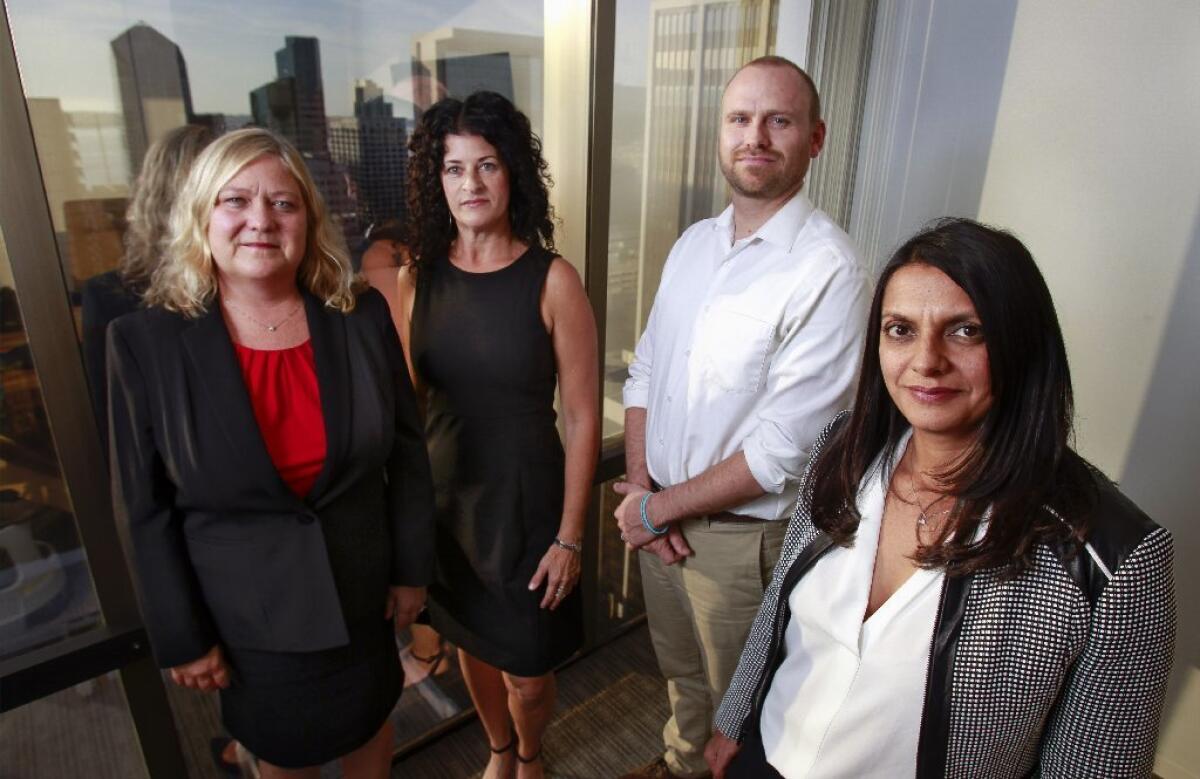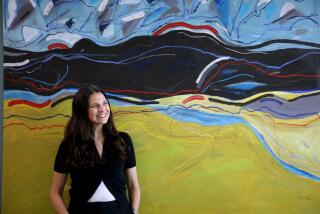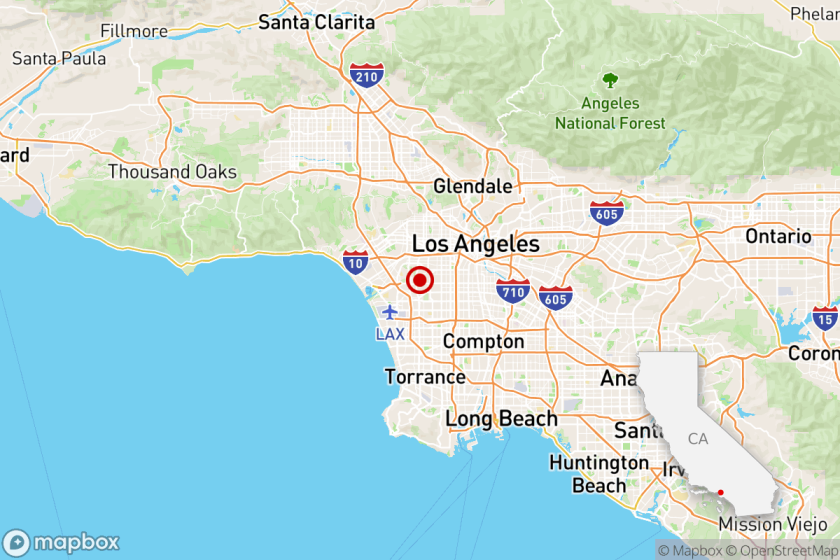‘A dog and pony show,’ lawyer in class-action suit says, recalling Trump University seminar

The Trump University lawsuit landed at a small downtown San Diego law firm the way so many cases do — with a phone call.
Aaron Olsen, an attorney at Zeldes Haeggquist & Eck, took the call in January 2010 and, unlike the prosecutors and other civil attorneys who had blown off former student Tarla Makaeff, he listened to her story.
For the record:
9:55 a.m. April 16, 2024An earlier version of this report incorrectly stated that Daniel Petrocelli defended O.J. Simpson in the civil trial. The article has been edited to reflect that he represented the Goldman family.
The class-action lawsuit she filed against Donald Trump and his defunct Trump University became a centerpiece of the presidential campaign, featured in debates and on “Saturday Night Live.” The end result: a $25 million settlement by the president-elect for thousands of former students 6½ years later.
Trump did not admit any liability or wrongdoing in settling the case, saying the resolution allows him to focus on his presidential transition.
For the attorneys in the two firms who worked on the case, taking on defendants like real estate mogul Donald Trump wasn’t new. They’d gone up against Apple, Pfizer, Walmart, Sony Electronics and Mattel. But none of them could have anticipated the trajectory this lawsuit would take as Trump went from celebrity to GOP presidential front runner to the nation’s next commander in chief.
In interviews with The San Diego Union-Tribune, the attorneys recounted one of the most significant lawsuits of their careers.
“Nobody could have seen Donald Trump’s rise politically,” attorney Helen Zeldes said. “We took the case long before the White House was a sparkle in his eye.”
Looking back, the lawyers who buried themselves in the case said the charisma and economic solutions Trump used to influence Trump University students are the same traits he used to win over voters.
“He says things that resonate with people and that people have been waiting to hear,” said San Diego attorney Jason Forge, who was among lawyers from the much larger Robbins Geller Rudman & Dowd firm brought on to help litigate the case. “He did that as a candidate and did that with Trump University. What do you want to hear most when economic times are at their worst? They want to hear there’s a way out of this. They want to hear there’s hope. A guy as successful as he’s been, and been through bad times financially, is who you want to hear from.
“The guy has an uncanny knack for sensing what people want to hear and what will motivate them,” Forge said.
That savvy helped launch him to the White House.
“His genius at creating his brand is really impressive,” said attorney Rachel Jensen. “We’ve seen that through this case. He knows how to create a narrative and get people motivated and knows how to close the deal.”
How the case began
When Zeldes heard about Makaeff’s call to her firm — a four-person operation in 2010 — her ears perked up.
“I thought, ‘Trump University. Is there a university I hadn’t heard of? Is this a real university? Do people really think this is a university?’” she recalled.
As luck would have it, a 90-minute Trump University preview seminar was being held in San Marcos. Zeldes decided to check it out.
“My heart broke,” Zeldes said. “I thought, wow, this is really a dog and pony show. You walk in and there’s these big life-sized posters of Donald Trump. I got to hear the pitch and see people really compelled by the pitch they were making. … They’d say ‘How many people lost equity on their homes? How many want to leave that legacy for their children? How many of you want to learn how to make that money back?’”
The attendees were encouraged to pay $1,500 for a three-day seminar to learn more, which led to pitches for a $35,000 yearlong program promising real estate riches, according to former students. Makaeff claimed to have spent about $60,000 in all.
Zeldes’ firm took the case on a contingency, but before filing the complaint in San Diego federal court the attorneys brought on Robbins Geller, which had more staff and resources.
Once the lawsuit was filed on April 30, 2010, the phone calls started coming in.
“I probably personally spoke to almost 400 people who took Trump University courses,” attorney Amber Eck recalled. “These are devastating stories.”
From seniors to business people to real estate entrepreneurs, the students had similar stories of being encouraged to max out one, two or three credit cards to pay for Trump University courses, Eck said, or to take out retirement savings, inheritances or home equity credit.
The attorneys’ big break in the case came when they began hearing from former Trump University employees. They leaked playbooks and scripts used by instructors long before the items were released in discovery.
The documents detailed the room layout during seminars, the temperature the thermometer should be set at (“no more than 68 degrees”), the many comebacks that employees could use when students were reluctant to put down money.
“They specifically set up the room so the exit would be blocked so it’d be difficult to get past a Trump University person,” Eck said.
Trump fights back

Early on in the case, Trump delivered a counterpunch, suing Makaeff for defamation.
“There was no grace period where there was smooth sailing,” said Jensen, of Robbins Geller. “This case always had challenges by virtue of who the defendant is.”
Trump’s suit made its way to the 9th U.S. Circuit Court of Appeals, and Makaeff prevailed.
Jensen questioned Trump during his first deposition in 2012 at Trump Tower in New York and described the encounter as confrontational. “He threatened to sue me and my firm. There was bullying and intimidation going on,” she said.
Trump aggressively defended his program. He and his legal team said Makaeff and other disgruntled students didn’t put in enough effort to succeed in business and partly blamed the downturn in the real estate market for their troubles.
“The student evaluations received throughout the courses of Trump University were extraordinarily positive,” Trump lawyer Daniel Petrocelli said in an interview. “People sought out this program because they wanted to better their lives, supplement their income, change jobs, reach out and try something new and different in their lives to challenge themselves, and that’s much of what the courses and instruction offered people.”
Forge, from Robbins Geller, was brought on as a lead litigator in the case in 2013. He’d gained a reputation as a hard-charging assistant U.S. attorney and was part of the team that prosecuted Rep. Randy “Duke” Cunningham in the largest bribery scandal in congressional history. He also brought his experience prosecuting white-collar criminals under the Racketeer Influenced and Corrupt Organizations Act to the Trump case.
“The more I thought about it the more I thought this could be a pretty good RICO case,” Forge said. “The allegations in this case are not that different from the kind of Ponzi schemes I worked on at the U.S. attorney’s office.”
The lawyers tried to add a RICO cause of action to the lawsuit, but it was denied. So they filed a separate class-action lawsuit using RICO. Art Cohen, a Northern California businessman and former student who had contacted the attorneys with offers to participate in the case, became the class representative.
Case put in national spotlight
U.S. Sen. Marco Rubio injected Trump University into the national conversion in February when he leveled a series of attacks against Trump during a televised Republican presidential debate.
“I was at the gym. I’m on the elliptical and the guys next to me are talking about, ‘Hey, did you hear about Trump University?’” Zeldes recalled. “The Republicans were using our case to try to get rid of Trump, then it became a household word.”
Trump’s lawyer said the case suddenly became a “political football.”
“The case was used, unfairly so, with enormous distortions by political opponents to try to take shots at Mr. Trump, and Mr. Trump handled himself deftly when asked about it. … His opponents were searching for anything they could to undermine his popularity with the public and used the case as a political weapon, and ended up obviously failing,” Petrocelli said.
He called the press coverage on the case overwhelmingly biased. “That was probably the biggest challenge, overcoming the negative publicity that portrayed the case in a very unfair and inaccurate light,” Petrocelli said.
That’s also when Trump lashed out at the judge overseeing the case, calling U.S. District Judge Gonzalo Curiel a “Mexican” who was biased against him for his views on immigration. Curiel was born in Indiana to Mexican immigrants.
But Trump’s rise politically did little to change the inner workings of the case, other than present logistical scheduling challenges, the attorneys said.
The intense media scrutiny had its effect on Makaeff, who’d been suffering from health problems and family issues and decided she couldn’t take the stress of being a class representative any longer. The judge allowed her to step back from the case. That left as named plaintiffs Sonny Low, 75, a retired foreign service officer in Chula Vista who works at Home Depot to pay off his Trump University debt, John Brown in New York, and J.R. Everett in Florida.
Trump gets deposed
Attorneys found a more cooperative, engaged Trump in his final two depositions, in December 2015 and January 2016.
“He would give much more candid responses than typical of a real polished CEO who knows how to smile and shine you on without really answering questions. That’s not his style,” said Forge, who did the questioning. “He gave answers to a lot of questions, and I would not question the sincerity at all. I respected him for giving us very real answers.
“It ties back into the persona he has, not as if his persona is a fake one. He wants to be seen, and it’s well earned. He’s somebody who calls it as he sees it.”
Eck, who was at the depositions, attributes Trump’s candor to the strong evidence that was piled up against him by that point. “Once you have someone in a box it’s easier to get the testimony,” she said. She also thinks Trump was anticipating the transcripts of the depositions would be made public — which they were.
The final deposition, at Trump International Hotel in Las Vegas, included friendly chit-chat.
“He was downright charming. He was very nice,” Forge said. “He asked me on break, ‘Are you surprised how I’m doing in the polls?’ And I said, ‘I have to say, I am.’
“‘That’s OK, so am I,’” Trump responded, according to Forge.
The conversation surrounding Trump’s campaign continued.
“I said, ‘A lot of things you are saying are really great. Other things are really scary,’” Forge said. Trump didn’t appear to take offense at the comment, he said.
The stunning downfall of San Diego Congressman Cunningham also came up.
“I said [Trump] was right on the money about how corrupt the system was, not just the rank corruption that [the Cunningham] case involved, but that so many people told us over the course of that investigation that if Cunningham would have been smarter, he would have worked the system to get just as much money without breaking the law.”
Both sides get ready for the trial
In federal court, the vast majority of civil cases settle. In this case, it was assumed by everyone that the battle would be waged at trial.
At the forefront of everyone’s mind: How in the world do you pick a jury for a case like this — two weeks after the defendant just won the most divisive presidential election in modern U.S. history?
“Obviously the political angle of it was unprecedented. It was going to be a visceral approach, a lot of gut level determinations,” Forge said. “It was hard to imagine what group of folks we were going to be left with who didn’t have strong feelings one way or another about the defendant. … From a clinical perspective, it was one of the things I was looking forward to the most. From a litigation perspective, it was a gigantic source of stress.”
Petrocelli, who represented the Goldman family in the civil trial against O.J. Simpson, agreed, saying he anticipated a Trump jury to be even more challenging to select.
In the end, it didn’t matter.
Days after Trump was elected, Judge Curiel strongly urged both sides to meet with U.S. District Judge Jeffrey Miller in an attempt to settle. The parties met about a week later in an intensive mediation session.
Each side sat in separate rooms, and Miller would go back and forth. Neither side exchanged dollar amounts. Miller was the only one with that information.
“Both sides took a tremendous amount of trust in Judge Miller,” Forge said.
It worked. The parties looped in the New York attorney general’s office — which in 2013 filed a similar lawsuit against Trump University — and a $25 million settlement was reached resolving all three cases.
“Mr. Trump felt it was in the best interests of the public and his duty to the office of the presidency to settle all the cases, even though we felt very confident in the merits of our position,” Petrocelli said. Settlement also meant avoiding protracted appeals that would have been likely in the case.
In the two San Diego cases, the 7,000 or so class members will be able to recover at least half of the money they spent on Trump University, possibly more.
The plaintiffs lawyers agreed not to take any costs or fees — a loss in the millions.
“The decision came from the very top of our firm. It was not a demand made,” Jensen said. “To make sure as a class they can recover the maximum amount, make sure our fees did not get in the way of allowing this to settle so our country could move on.”
Attorney Alreen Haeggquist said it was a difficult decision, but the right one.
“It’s not like a bill goes out at the end of every month. No one is paying for your time. When you’re with a small firm, you struggle with having to keep it all going, paying support staff and employees and keep the lights on while doing this kind of work.”
Does this settlement mean Trump may be more willing to resolve the myriad other lawsuits pending against him?
“If anyone thinks this sets the precedent to cause him to roll over, I strongly advise them to think again,” Forge said.
Davis writes for the San Diego Union-Tribune.
For breaking news in L.A., follow @lanow.
ALSO
Trump’s response on Russia draws push back from GOP senators
Op-Ed by Doyle McManus: There’s no sign that Congress will stand up to Trump
‘SNL:’ Bryan Cranston revives his ‘Breaking Bad’ character to satirize Trump’s cabinet picks
More to Read
Start your day right
Sign up for Essential California for news, features and recommendations from the L.A. Times and beyond in your inbox six days a week.
You may occasionally receive promotional content from the Los Angeles Times.






